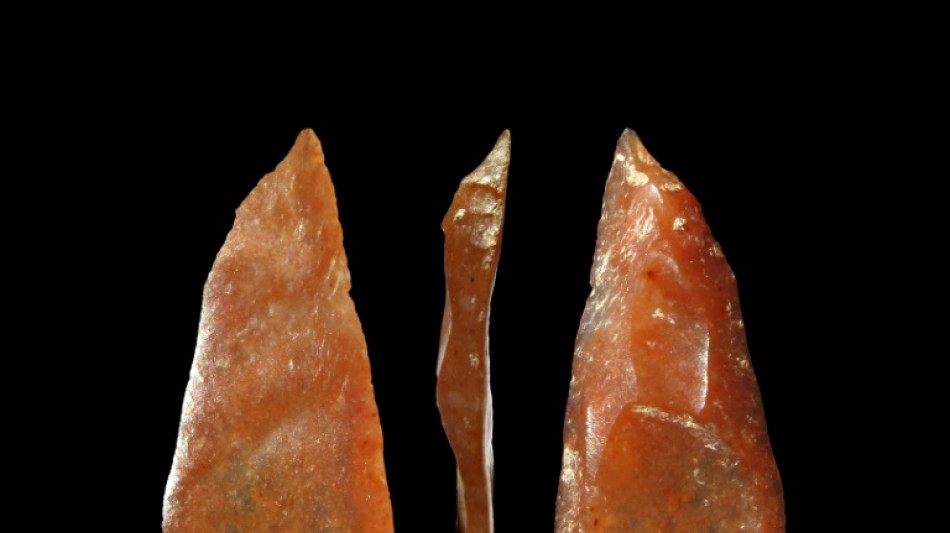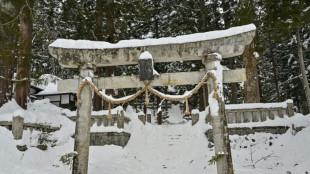
-
 Upset stomach to overdose: A child's ordeal at France abuse trial
Upset stomach to overdose: A child's ordeal at France abuse trial
-
Greenpeace trial begins in North Dakota in key free speech case

-
 Mercedes unveil 2025 F1 car ahead of pre-season testing
Mercedes unveil 2025 F1 car ahead of pre-season testing
-
Macron holds 'very friendly' Trump talks as transatlantic ties shaken

-
 Critically-ill pope 'not in pain': Vatican source
Critically-ill pope 'not in pain': Vatican source
-
Trump names right-wing podcaster as FBI deputy director

-
 'Monster Hunter' on prowl for new audiences as latest game drops
'Monster Hunter' on prowl for new audiences as latest game drops
-
Stunned SPD turns to supporting role in new German government

-
 Russian court upholds French researcher's jail sentence
Russian court upholds French researcher's jail sentence
-
Apple says to invest $500 bn in US as Trump tariffs bite

-
 French actor Gerard Depardieu probed for tax fraud: source close to case
French actor Gerard Depardieu probed for tax fraud: source close to case
-
Over 7,000 killed in eastern DR Congo since January: PM

-
 Macron meets Trump as transatlantic alliance shaken
Macron meets Trump as transatlantic alliance shaken
-
Apple says to invest $500 bn in US over four years, hire 20,000 staff

-
 Liverpool's Van Dijk wants Anfield to be 'horrible' during title run-in
Liverpool's Van Dijk wants Anfield to be 'horrible' during title run-in
-
Swedish major winner Nordqvist named Europe's Solheim Cup captain

-
 Marseille president Longoria says 'no corruption' in Ligue 1 after outburst
Marseille president Longoria says 'no corruption' in Ligue 1 after outburst
-
US shuns climate science meeting as UN warns 'time is not on our side'

-
 New Zealand's Bracewell puts Bangladesh in a spin in Champions Trophy
New Zealand's Bracewell puts Bangladesh in a spin in Champions Trophy
-
'Bullish' Bavuma wary of Australia ahead of Champions Trophy clash

-
 German vote winner Merz seeks to build govt as Europe waits
German vote winner Merz seeks to build govt as Europe waits
-
Muted London fashion week wraps up with Burberry show

-
 Zelensky wants peace 'this year' on third anniversary of Russian invasion
Zelensky wants peace 'this year' on third anniversary of Russian invasion
-
Frankfurt stocks, euro rise on German vote outcome

-
 Maresca says Chelsea are over-reliant on Palmer
Maresca says Chelsea are over-reliant on Palmer
-
German business urges 'new beginning' after election

-
 UN warns nations at climate science meeting 'time is not on our side'
UN warns nations at climate science meeting 'time is not on our side'
-
Critically-ill pope had a good night, Vatican says

-
 Asian markets track Wall St loss; Frankfurt lifted by German vote
Asian markets track Wall St loss; Frankfurt lifted by German vote
-
Paedophile French surgeon on trial for abusing almost 300 patients

-
 Zelensky hails Ukraine's 'heroism' on third anniversary of Russia's invasion
Zelensky hails Ukraine's 'heroism' on third anniversary of Russia's invasion
-
In Ukraine, anticipating the 'next' war with Russia

-
 Macron to present Trump with 'proposals' on peace in Ukraine
Macron to present Trump with 'proposals' on peace in Ukraine
-
Zelensky hails Ukraine's 'heroism' on third annniversary of Russia's invasion

-
 Cavs hold off Grizzlies for seventh straight NBA win
Cavs hold off Grizzlies for seventh straight NBA win
-
China's Alibaba to invest $50 bn in AI, cloud computing

-
 Vatican thriller 'Conclave' wins top prize in SAG Awards upset
Vatican thriller 'Conclave' wins top prize in SAG Awards upset
-
Dominant Ducati unleash deposed MotoGP kings Marquez and Bagnaia

-
 Premier League champions-elect Liverpool leave mark on Man City
Premier League champions-elect Liverpool leave mark on Man City
-
Indonesia launches new multi-billion-dollar sovereign wealth fund

-
 South Korean fans soak up nostalgia with vintage Japanese superheroes
South Korean fans soak up nostalgia with vintage Japanese superheroes
-
Most Asian markets track Wall St loss; Hong Kong extends gains

-
 German vote winner Merz faces tough talks to build govt
German vote winner Merz faces tough talks to build govt
-
Japan warns of avalanches, icy roads ahead of more snow

-
 All Black Caleb Clarke admits dangerous driving: NZ media
All Black Caleb Clarke admits dangerous driving: NZ media
-
Debutants San Diego stun Galaxy with win in Los Angeles

-
 India's Modi uses mega Hindu festival to burnish credentials
India's Modi uses mega Hindu festival to burnish credentials
-
Surprise rebel alliance could give Sudan's beleaguered RSF a boost

-
 Three years after Russia invasion, UN faces difficult votes on Ukraine
Three years after Russia invasion, UN faces difficult votes on Ukraine
-
German 'rust belt' town spotlights growing appeal of the far right

| RBGPF | 0.87% | 65.42 | $ | |
| RYCEF | 0.26% | 7.72 | $ | |
| CMSC | -0.21% | 23.32 | $ | |
| GSK | 1.07% | 37.035 | $ | |
| SCS | 0.24% | 12.34 | $ | |
| VOD | 3.42% | 8.656 | $ | |
| BCC | -1.27% | 105.45 | $ | |
| BTI | 0.76% | 38.14 | $ | |
| RIO | -0.53% | 63.195 | $ | |
| RELX | -0.04% | 49.268 | $ | |
| NGG | 1.65% | 62.34 | $ | |
| BCE | 0.68% | 24.135 | $ | |
| JRI | -0.08% | 12.79 | $ | |
| AZN | 0.45% | 74.555 | $ | |
| CMSD | 0.21% | 23.47 | $ | |
| BP | 0.01% | 33.895 | $ |

Study places Homo sapiens in Europe earlier than thought
Homo sapiens ventured into Neanderthal territory in Europe much earlier than previously thought, according to an archaeological study published in Science magazine on Wednesday.
Up to now, archaeological discoveries had indicated that Neanderthals disappeared from the European continent about 40,000 years ago, shortly after the arrival of their "cousin" Homo sapiens, barely 5,000years earlier and there was no evidence of an encounter between these two groups.
The new discovery, by a team of archaeologists and palaeoanthropologists led by Ludovic Slimak of Toulouse University, pushes back the arrival of Homo sapiens in Western Europe to around 54,000 years ago.
Another remarkable finding of the research is that the two types of humans alternated in inhabiting the Mandrin cave in what is now the Rhone region of southern france.
The Mandrin site, first excavated in 1990, includes layer upon layer of archaeological remains dating back over 80,000 years.
"Mandrin is like a kind of neandertalian Pompeii, without catastrophic events, but with continuous filling of sands in the cave deposited progressively by a strong wind, the Mistral," Slimak told AFP.
His team uncoevered a layer, known as the "E layer", containing at least 1,500 cut flint points, more finely executed than the points and blades in the layers above and below.
Very small in size, some of them less than a centimetre in length, these points "are standardised, to the nearest millimetre, something we haven't seen at all with Neanderthals," said Slimak, a specialist in Neanderthal societies.
These, he explained, were probably arrowheads, unknown in Europe at that time.
He attributes this production to a culture called Neronian, linked to several sites in the Rhone area.
- Milk tooth discovery -
In 2016, Slimak and his team visited the Peabody Museum in Harvard to compare their discoveries with a collection of carved fossils from the Ksar Akil site at the foot of Mount Lebanon, one of the major sites of the expansion of Homo sapiens to the east of the Mediterranean.
The similarity between the techniques used convinced Slimak that the findings at the Mandrin site were the first traces of Home Sapiens found in Europe.
A milk tooth found in the "E layer" confirmed his suspicions.
In all researchers found nine teeth at the Mandrin cave site, belonging to six individuals.
These ancient teeth were entrusted to Clement Zanolli, a palaeoanthropologist at the University of Bordeaux.
Using microtomography, similar to medical scanning technology, the verdict was clear.
The milk tooth from the "E" layer" was the only modern human tooth found at the site.
That "fossil molar from a modern human child provides the earliest known evidence of modern humans in western Europe", the Natural History Museum in London said in a statement.
- Co-existence? -
The archaeological team then used a pioneering technique, fuliginochronology, which analyses layers of soot impregnating the walls of a cave and the traces of ancient fires.
The reachers demonstrated that "this Modern human population occupied this Rhone territory for some 40 years," said Slimak.
At some point, the two populations either co-existed in the cave or on the same territory, the researcher concluded.
He imagines that Neanderthals could have served as guides to Homo Sapiens to lead him to the best sources of flint available, some of which were located up to 90 kilometres (55 miles away.
"Nothing new under the sun… This is precisely what happened when Europeans began the colonization of the Americas or Australia," he noted.
"The findings from Mandrin are really exciting and are another piece in the puzzle of how and when modern humans arrived in Europe,? concludes Professor Chris Stringer, co-author of the study and a specialist in human evolution at the Natural History Museum in London.
"Understanding more about the overlap between modern humans and other hominins in Eurasia is vital to understanding more about their interactions, and how we became the last remaining human species," he added.
This overlap, which was evident in Mandrin, now places the Rhone region as a "major migration corridor (for Homo sapiens) enabling them to reach the Mediterranean and continental European areas", said Slimak, who promises more discoveries from the Mandrin site.
W.Lapointe--BTB

